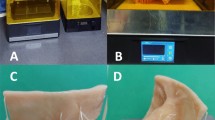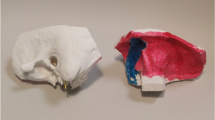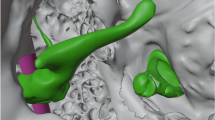Abstract
Purpose
To relate the creation and expert validation (face and content validity) of an affordable three-dimensional (3-D) printed model of temporal bones with chronic otitis media with cholesteatoma (COMC) as a simulator for mastoidectomy.
Methods
We performed computed tomography (CT) of the temporal bones of a patient with COMC followed at the University of São Paulo (USP) Hospital with 3-D Slicer to create a 3-D model of the affected bone using light-curing resin and silicone (cholesteatoma). The final 3-D printed images were scored by 10 otologists using a customized version of the Michigan Standard Simulation Scale Experience (MiSSES). Internal consistency and inter-rater reliability were assessed using Cronbach’s α and intraclass correlations.
Results
Otologists consistently scored the model positively for fidelity, educational value, reactions, and the overall model quality. Nine otologists agreed that the model was a good educational device for surgical training of COMC. All experts deemed the model ready—or nearly ready—for use. The final cost of the model, including raw materials and manufacturing, was 120 USD.
Conclusions
Using 3-D printing technology, we created the first anatomically accurate, low-cost, disease-reproducing 3-D model of temporal bones for mastoidectomy training for cholesteatoma.




Similar content being viewed by others
Availability of data and materials
My manuscript has no associated data.
Code availability
Not applicable.
References
Yoshiyasu Y, Chang DR, Bunegin L et al (2019) Construct validity of a low-cost medium-fidelity endoscopic sinus surgery simulation model. Laryngoscope 129(7):1505–1509
Deonarain AR, Harrison RV, Gordon KA et al (2021) Synthetic simulator for surgical training in tracheostomy and open airway surgery. Laryngoscope 131(7):E2378–E2386
de Souza MA, Bento RF, Lopes PT, de Pinto Rangel DM, Formighieri L (2021) Three-dimensional printing in otolaryngology education: a systematic review. Eur Arch Otorhinolaryngol 1–1
Lee M, Ang C, Andreadis K, Shin J, Rameau A (2021) An open-source three-dimensionally printed laryngeal model for injection laryngoplasty training. Laryngoscope 131(3):E890–E895
Lee AY, Fried MP, Gibber M (2017) Improving rhinology skills with simulation. Otolaryngol Clin N Am 50(5):893–901
Vaitaitis VJ, Dunham ME, Kwon YC et al (2020) A surgical simulator for tympanostomy tube insertion incorporating capacitive sensing technology to track instrument placement. Otolaryngol Head Neck Surg 162(3):343–345
Wong V, Unger B, Pisa J, Gousseau M, Westerberg B, Hochman JB (2019) Construct validation of a printed bone substitute in otologic education. Otol Neurotol 40(7):e698–e703
Gadaleta DJ, Huang D, Rankin N et al (2020) 3-D printed temporal bone as a tool for otologic surgery simulation. Am J Otolaryngol 41(3):102273
McMillan A, Kocharyan A, Dekker SE et al (2020) Comparison of materials used for 3-D-printing temporal bone models to simulate surgical dissection. Ann Otol Rhinol Laryngol 129(12):1168–1173
Gabrysz-Forget F, Rubin S, Nepomnayshy D, Dolan R, Yarlagadda B (2020) Development and validation of a novel surgical simulation for parotidectomy and facial nerve dissection. Otolaryngol Head Neck Surg 163(2):344–347
Chien WW, da Cruz MJ, Francis HW (2021) Validation of a 3-D-printed human temporal bone model for otology surgical skill training. World J Otorhinolaryngol Head Neck Surg 7(2):88–93
Seagull FJ, Rooney DM (2014) Filling a void: Developing a standard subjective assessment tool for surgical simulation through focused review of current practices. Surgery 156(3):718–722
Da Cruz MJ, Francis HW (2015) Face and content validation of a novel three-dimensional printed temporal bone for surgical skills development. J Laryngol Otol 129(suppl 3):S23–S29
Meyer C, Noda F, Folsom CR (2020) Hybrid surgical simulator: a temporal bone simulator validation study of the Stryker surgical simulator (S3). Mil Med 185(11–12):e2026–e2031
Chang DR, Lin RP, Bowe S et al (2017) Fabrication and validation of a low-cost, medium-fidelity silicone injection molded endoscopic sinus surgery simulation model. Laryngoscope 127(4):781–786
Alwani MM, Svenstrup TJ, Bandali EH et al (2020) Validity testing of a three-dimensionally printed endoscopic sinonasal surgery simulator. Laryngoscope 130(12):2748–2753
Gamer M, Lemon J, Fellows I, Singh P (2019) IRR: various coefficients of interrater reliability and agreement. R package version, 0.84.1
Rizopoulos D (2018 ) Latent trait models under IRT. R package version 1. 1–1
Canzi P, Capaccio P, Marconi S et al (2020) Feasibility of 3-D printed salivary duct models for sialendoscopic skills training: Preliminary report: preliminary report. Eur Arch Otorhinolaryngol 277(3):909–915
Nguyen Y, Mamelle E, De Seta D, Sterkers O, Bernardeschi D, Torres R (2017) Modifications to a 3-D-printed temporal bone model for augmented stapes fixation surgery teaching. Eur Arch Otorhinolaryngol 274(7):2733–2739
Bento RF, Rocha BA, Freitas EL, Balsalobre FA (2019) Otobone ®: three-dimensional printed temporal bone biomodel for simulation of surgical procedures. Int Arch Otorhinolaryngol 23(4):e451–e454
Vimawala S, Gao T, Goldfarb J et al (2020) Initial experience using 3-dimensional printed models for head and neck reconstruction in Haiti. Ear Nose Throat J 10:145561320938920
Acknowledgements
The authors thank the members of the Otorhinolaryngology Foundation for providing access to their 3D-printing facility and expert consultation, specially Dr Lucas Formighieri, radiologist.
Funding
All authors certify that they have no affiliations with or involvement in any organization or entity with any financial interest or non-financial interest in the subject matter or materials discussed in this manuscript.
Author information
Authors and Affiliations
Contributions
RFB and MAdS conceived the idea for this article. MAdS collected relevant data and coordinated the creation of the model. PTL and RFB analyzed the data after discussions with MAdS. MAdS and PTL drafted the paper. All authors read and approved the final manuscript.
Corresponding author
Ethics declarations
Conflict of interest
The authors have no conflicts of interest to declare that are relevant to the content of this article.
Ethics approval
It was approved by the research ethics committee of the USP Hospital, under opinion 4.734.389.
Additional information
Publisher's Note
Springer Nature remains neutral with regard to jurisdictional claims in published maps and institutional affiliations.
Rights and permissions
About this article
Cite this article
de Souza, M.A., Bento, R.F. & Lopes, P.T. A three-dimensionally printed otological model for cholesteatoma mastoidectomy training. Eur Arch Otorhinolaryngol 280, 671–680 (2023). https://doi.org/10.1007/s00405-022-07536-y
Received:
Accepted:
Published:
Issue Date:
DOI: https://doi.org/10.1007/s00405-022-07536-y




